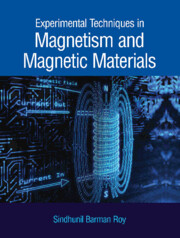Book contents
- Frontmatter
- Dedication
- Contents
- Preface
- I Introduction to Magnetism and Magnetic Materials
- II Basic Phenomenology of Magnetism
- III Experimental Techniques in Magnetism
- Appendix A Magnetic Fields and Their Generation
- Appendix B Units in Magnetism
- Appendix C Demagnetization Field and Demagnetization Factor
- Index
8 - Optical Methods
Published online by Cambridge University Press: 27 October 2022
- Frontmatter
- Dedication
- Contents
- Preface
- I Introduction to Magnetism and Magnetic Materials
- II Basic Phenomenology of Magnetism
- III Experimental Techniques in Magnetism
- Appendix A Magnetic Fields and Their Generation
- Appendix B Units in Magnetism
- Appendix C Demagnetization Field and Demagnetization Factor
- Index
Summary
Magneto-optical Effects
The magneto-optical effect arises in general as a result of an interaction of electromagnetic radiation with a material having either spontaneous magnetization or magnetization induced by the presence of an external magnetic field. Michael Faraday in 1846 demonstrated that in the presence of a magnetic field the linear polarization of the light with angular frequency w was rotated after passing through a glass rod. This rotation is now termed as Faraday rotation, and it is proportional to the applied magnetic field B. The angle of rotation θ(w) can be expressed as [1].
Here V(w) is a constant called the Verdet constant, which depends on the material and also on the frequency w of the incident light; |B| is the magnitude of the applied magnetic field, and l thickness of the sample. The Faraday effect is observed in non-magnetic as well as magnetic samples. For example, the Verdet constant of SiO2 crystal is 3.25 × 10−4 (deg/cm Oe) at the frequency w = 18300cm−1 [1]. This implies that a Faraday rotation of only a few degrees can be observed in a sample of thickness 1 cm in a magnetic field of 10 kOe. A much larger Faraday rotation can, however, be observed in the ferromagnetic materials in the visible wavelength region under a magnetic field less than 10 kOe.
In 1877 John Kerr showed that the polarization state of light could be modified by a magnetized metallic iron mirror. This magneto-optical effect in the reflection of light is now known as the magneto-optical Kerr effect (MOKE), and it is proportional to the magnetization M of the light reflecting sample. Today MOKE is a popular and widely used technique to study the magnetic state in ferromagnetic and ferrimagnetic samples. With MOKE it is possible to probe samples to a depth, which is the penetration depth of light. This penetration depth can be about 20 nm in the case of metallic multilayer structures. In comparison to the conventional magnetometers like vibrating sample magnetometer and SQUID magnetometer which measure the bulk magnetization of a sample, MOKE is rather a surface-sensitive technique.
- Type
- Chapter
- Information
- Experimental Techniques in Magnetism and Magnetic Materials , pp. 169 - 190Publisher: Cambridge University PressPrint publication year: 2023

